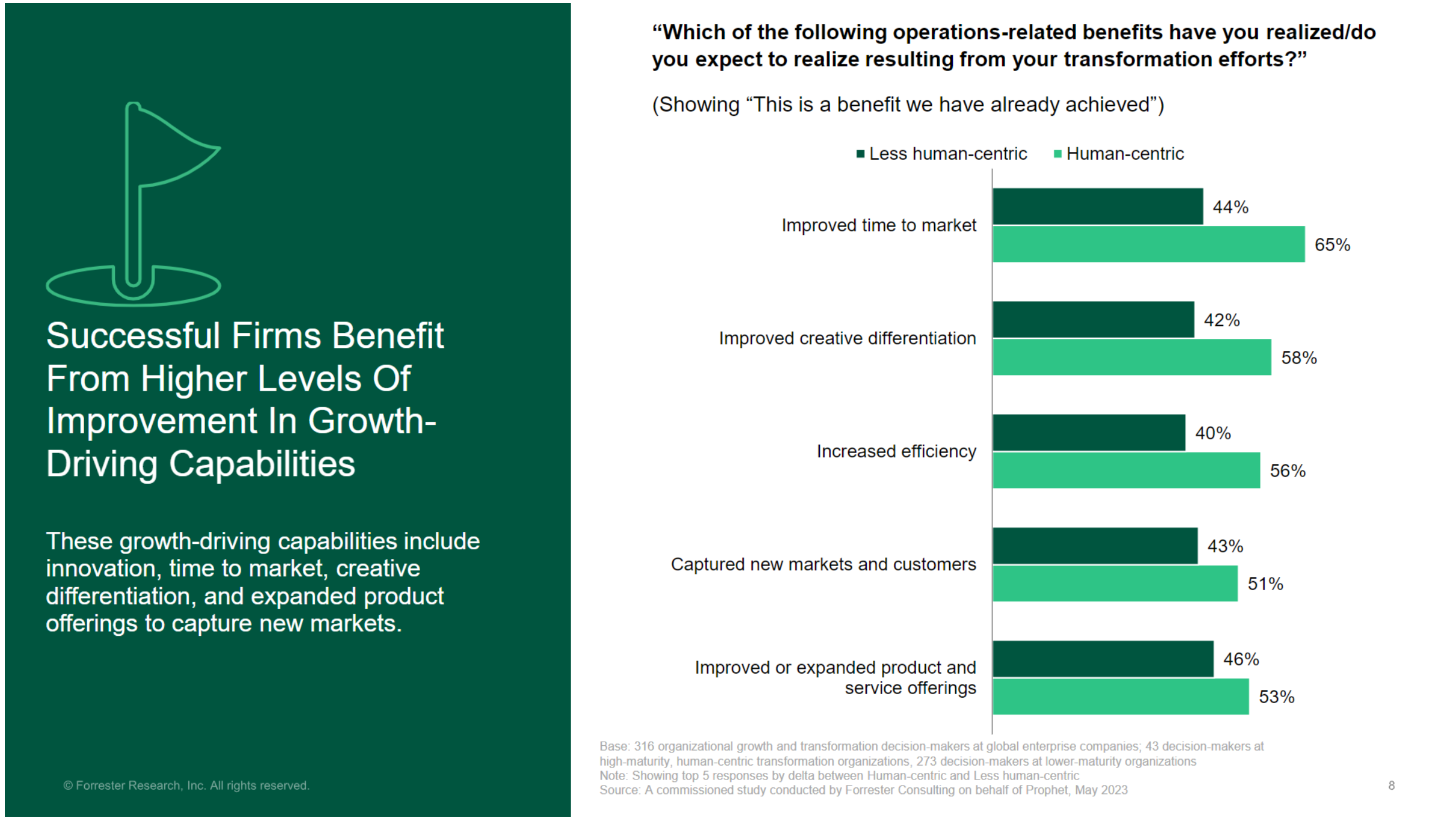BLOG
The Human Factor: The Secret to Modern Change Management
Human-centricity leads to more successful transformations, with outsized revenue growth and higher employee satisfaction.
Corporate coldness doesn’t work any longer. Just ask Elon Musk. Months after his brutal mass layoffs – with many of Twitter’s 6,000 downsizing victims finding they’d gotten the axe only when they lost access to email – the company is still struggling. Ad revenues and stock performance have plummeted. Consumers are racing to competitors, including Threads. And all because he forgot the most essential rule in business today: People matter. Change initiatives require empathy to succeed even when making tough calls, like reducing staff.
Prophet calls this a human-centered approach to change. Our research and experience prove that companies approaching transformation from this point of view are more agile and responsive to the needs of their people and have more flexibility when it comes to adjusting roadmaps as they move through their journey. They have more robust, loyal workforces because they align new governance policies around people, not technology. Even before profits and efficiencies, these companies center their strategies on the people in the business.
The impact is clear. In May 2023, Prophet commissioned Forrester to explore how firms use human-centricity to design their transformation initiatives and assess their performance. This joint research confirmed that firms that adopt a human-centric focus were:
- 10x more likely to see revenue growth of 20% or higher
- better able to engage employees and create impactful stakeholder experiences
- able to improve overall levels of innovation, time to market, creative differentiation, and capture new markets with enhanced product offerings

We’re not saying this approach is straightforward. If the last few years have proved anything, change isn’t linear. Leaders face new demands and are often driving multiple changes simultaneously. CEO tenure keeps falling. And even though murky economic forecasts are causing layoffs in many sectors, investors still demand growth. It often feels that the expectation that businesses change and then keep changing is more significant than ever.
Yet our research and experience working with change leaders have shown us that it pays to adopt a human-centered approach – ensuring strategies are holistic and integrated improves the success of any single initiative.
Prophet’s Four Directions of Change Model Cultivates a Human-Centric Mindset
Change isn’t one-dimensional. Neither are people. So human centricity can’t be, either. By definition, it’s holistic. It requires a constant shift in perspective, understanding no organization or industry operates in a vacuum. All businesses, from small B2B companies to sprawling consumer giants, work in constantly expanding ecosystems.
To successfully navigate this expansion, we believe leaders need to pay attention and respond to each “dimension” at which change occurs. Four directions are essential:
1. Look outside-in.
Real-world forces and societal changes are happening all the time. Workforce demands and expectations that emerged in the last few years continue to intensify, and organizations must respond. The top triggers? Employee well-being and mental health, cited by 71% of companies we surveyed, sustainability and climate change (65%), the ongoing challenges of remote and hybrid work (64%) and diversity, and equity and inclusion (61%). Addressing these needs takes an integrated and experimental approach – aligning people, operations and technology functions to address new ways of working.
2. Lean on the existing culture, inside-out.
Leaders should consistently assess their organization’s aptitude or fitness for change and build a unique change journey from this starting point. We know the most effective change accelerator is a powerful, actionable ambition. But to reach those goals and set an ambition, organizations need an honest assessment of their performance across critical fundamentals. They need to know how well they enable employees to adapt to required changes and build the best mechanisms to support them. They need to push decision-making rights downward, as reducing hierarchical decisions improves asset allocation and boosts effectiveness. Leaders should leverage their organization’s strengths – reinforcing the elements that drive pride and comfort around change while painting a brighter future in areas where change will improve their people and the business.
3. Coordinate a leader-led change.
Leaders need to communicate, direct and model the change desired. Unless executives believe in and model the change required, it will fail. Our research on how well companies collaborate for transformation finds that leaders who don’t practice what they preach are a leading cause of initiative failure. Additionally, having an aligned leadership team is key to managing prioritization and execution – ensuring there’s a coordinated effort to focus on what matters and manage capacity internally. When defining “the way we do things around here” and motivating employees to adopt these same behaviors, senior leaders must act first to exemplify what effort and success look like.
4. Engage from the ground up.
Leaders include those impacted most in the strategy, development and activation. Companies can decrease implementation time and increase employee engagement by including members of the affected employee groups in strategic change initiatives, such as having them co-create solutions, recognizing them through stories of behaviors in action, or elevating them as change champions. When doing this, it is critical to ensure representation across race, gender, tenure, generation, and geography in addition to business units and levels.
Managing Across These Four Directions in Action: How It Works
The new CEO of the largest business unit of a major global industrial client asked for our help as she took on her role, recognizing that to achieve sustainable growth, significant change was needed inside the organization, both in mindset and ways of working. We started by building a picture of the current cultural dynamics for her and her leadership team and integrated this into the strategy development.
With this integrated foundation, we were able to codify the key behavioral shifts required and the program of work across the cultural ecosystem required to enable this. The interdependency of strategy and culture inherent in the program ensured that the change work itself was inside-out as well as outside-in, leader-led of course, but also focused on front-line engagement and performance.
At its heart, this change journey was shaped from the ground up. Our work was defined by reviewing key employee insights and engaging the organization in identifying the key shifts we needed to make to achieve our ambition.
From the outset, a leader-led principle was established for this work, reflecting the importance of leaders not just understanding but championing and role modeling change. Initially, key leadership groups input into the assessment and then helped co-create the program of work. The beginning of this journey was then largely focused on leadership skills and capabilities. We defined a multi-stage journey with different levels of leadership to ensure alignment, championship, connection and focus in owning the transformation. This involved both regular engagements as well as dedicated events like full-day in-person summits (held twice- yearly since).
Naturally, the work was dominantly inside-out – building a compelling “story” for the journey the organization was on and using this to help all employees understand the criticality of the strategy and culture work driven by their purpose. The “story” activation approach was informed by engaging the front line – getting the voice of the day-to-day operators into the work. Helping these audiences fully appreciate how their work delivers real value in the world has been instrumental – with 84% of employees feeling personally connected to purpose in their latest employee voice findings.
Outside-in, we built a renewed partnership with union leaders – a critical strategy in what is a heavily unionized working environment where relations had historically been strained. This collaboration with union leaders enabled us to align on a set of central issues to be resolved – ranging from inclusion and diversity to safety and future of work implications.
The program has run for three years – and in that time all four of these change dimensions have been sustained – even as different focus areas for the work have evolved. Our work together continues to transform the way the organization operates and how it maintains relevance in such a rapidly changing market and world. Importantly, the purpose is frequently cited as one of the key reasons employees join and stay with the organization. Survey results also show that our work has helped to align and guide day-to-day actions of employees across the organization.
FINAL THOUGHTS
For leaders who hope to create durable organizational changes, meeting people where they are is important. Using a human-centric framework, companies can develop transformation strategies that help all stakeholders. Human-centric organizations are more flexible and dynamic and better able to find their way to uncommon growth.

